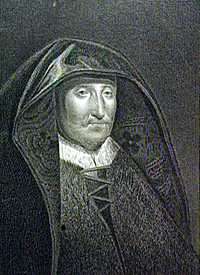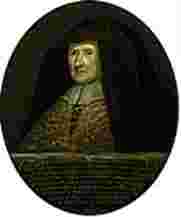Katherine FitzGerald, Countess of Desmond
Katherine FitzGerald, Countess of Desmond (c. 1504 – 1604) was a noblewoman of the Anglo-Norman FitzGerald dynasty in Ireland. English writers of the Tudor period, including Sir Walter Raleigh, helped popularise "the old Countess of Desmond" as a nickname for her, due to her longevity. One estimate placed her age at death in excess of 120 years. Another ranged as high as 140. Most likely she lived to about 100.[1]

Life
Lady Desmond was the daughter of Sir John FitzGerald, second Lord of Decies in Waterford, and Ellen Fitzgibbon. She was probably born at Dromana, in County Waterford. In 1529, she married, becoming the second wife of Thomas FitzGerald, 11th Earl of Desmond (1454–1534), "her cousin german once removed." The couple had a single daughter, also named Katherine, and she remained a widow following the death of her husband in 1534.

In later life, Lady Desmond was party to a property dispute typical of late-Tudor Ireland (1485–1603). Her husband had granted her a life tenancy in Inchiquin Castle, about 5 miles southwest of the town of Youghal, in Munster. Upon the Countess Desmond's death the castle was to revert to the line of the Earls of Desmond. In 1575, she passed title to the castle and lands in trust, by deed, to the incumbent earl, Gerald FitzGerald, who then passed it in trust to his servants.

Following the earl's attainder in 1582, whereby his estate fell to the Crown after the Desmond Rebellions, Inchiquin Castle and its lands were granted to New England colonist Sir Walter Raleigh who then leased out some of the land while preserving the life interest of the Countess in the castle. She survived far beyond Raleigh's expectations, and Sir Richard Boyle, who purchased Raleigh's colonial possessions in Ireland, including the castle, brought proceedings to evict the old lady.
A legend claims that, to protect her interests in the castle, the impoverished "old Countess" set out from Cork in 1604. After sailing to Bristol, she walked the road to London with her invalid 90-year-old daughter who she pulled along in a cart. In the 19th century it was claimed that this story arose from a confusion with another dowager countess of Desmond, who travelled to London to petition Elizabeth I. In London, her petition was presented to King James I. She returned to Inchiquin and died later the same year.
Death
Lady Desmond reportedly walked every week to her local market town, a distance of 4–5 miles, even after her return from London in 1604. It was said that all her teeth had been renewed just a few years earlier. She died after falling from a tree. Historians of the time disagreed as to the type of tree: Robert Sidney stated it was a nut tree, and that she fell, hurt her thigh, contracted fever and died. Another attributed her death to have been caused by a fall from a cherry tree she was picking. She is believed to be buried, with her husband, in a Franciscan Friary at Youghal. Clodagh Tait has questioned the generally accepted date of death of 1604, citing evidence that Lady Katherine may have died as early as 1575.
There are two portraits of Lady Desmond whose provenance is confirmed and a third whose authenticity is less well-settled.
Age
Raleigh, in his History of the World, maintained that Lady Desmond married in the time of King Edward IV (1461–1483), making her at least 135 years old at the time of her death. She was said to have danced with King Richard III, then Duke of Gloucester. In fact, she could not have been married earlier than 1505, as her husband's first wife, Sheila (Gilis) the daughter of the lord of Muskerry, was still alive in that year. The tradition that she died at age 140 was recounted in Fynes Moryson's Itinerary and Sir Francis Bacon's History of Life. Harington, writing in 1605, referred to a man who lived longer than 140 years, and to a woman, "and she a countess," who lived longer than 120. If Katherine FitzGerald married in her early twenties, this latter description would match her.[2]
Portraits
The text below Nathaniel Grogan's 1806 engraving of Lord Kerry's portrait reads as follows:
- Catherine Fitz-Gerald (the long lived) Countess of Desmond
- From an original family picture of the same size
- Painted on Board in the Possession of The Right Honourable Maurice Fitz-Gerald, Knight of Kerry &c. &c. &c.
- To whom this plate is most respectfully dedicated by his very obedient and much obliged humble servant Henry Pelham
- This illustrious Lady was born about the year 1464, was married in the Reign of Edward IV, lived during the entire reigns of Edward V, Richard III, Henry VII, Henry VIII, Edward VI, Mary & Elizabeth, and died on the latter end of James I, or the beginning of Charles I Reigns at the great age (as is generally supposed) of 162 years.
- Published as the act directs at Bear Island 4 June 1806 by Henry Pelham Esq.
On the back of the original painting, stated to have been executed during the Countess of Desmond's final visit to London, the following appears to have been painted:
- Catherine, Countess of Desmond, as she appeared at ye court of our Sovereign Lord, King James, in this present year, A.D. 1614,
- and in ye 140th yeare of her age. Thither she came from Bristol, to seek relief, ye house of Desmond having been ruined by attainder.
- She was married in ye reigne of King Edward IV., and in ye course of her long pilgrimage, renewed her teeth liuice. Her principal residence is at Inchiquin, in Munster, whither she undauntedlie proposeth (her purpose accomplished) incontinentlie to return. Laus Deo.
References
- Anne Chambers As Wicked a Woman (Dublin, 1986), pp. 232–235. ISBN 0-86327-190-1.
- The Venerable Archdeacon A. B. Rowan, "The Olde Countess of Desmond: her Identitie; her Portraiture; her Descente" in The Dublin Review, vol. LI [1862], p. 51.
- A.B.R., 'The Old Countess of Desmond' in Notes and Queries 1851, p. 305
- Henry Pelham, 'The Old Countess of Desmond', in Notes and Queries, 1852, pp. 305–306
- A.E., Bray, 'The Old Countess of Desmond' in Notes and Queries, 1852, pp. 564–565
- Anthony M. McCormack, 'Fitzgerald, Katherine, countess of Desmond (d. 1604), Oxford Dictionary of National Biography (Oxford, OUP, 2004).
- Clodagh Tait, 'The Old Countess, the Geraldine Knight and the Lady Antiquarian: a Conspiracy Theory Revisited', 21, History Ireland. Early Modern History (1500-1700), (May/June, 2013).
External links
- "The Countess of Desmond" in the Dublin Review pp. 51ff.